Sarah returned, all graduated and grown up, on Monday and I was promptly “fired” as a TA. “Fired” so I could spend some time recording gull alarm calls.
So Tuesday morning, as the class boarded the Heiser and set off for a day of birding on the mainland, I hoisted my newly outfitted microphone on a tripod and set off up the turbine trail.
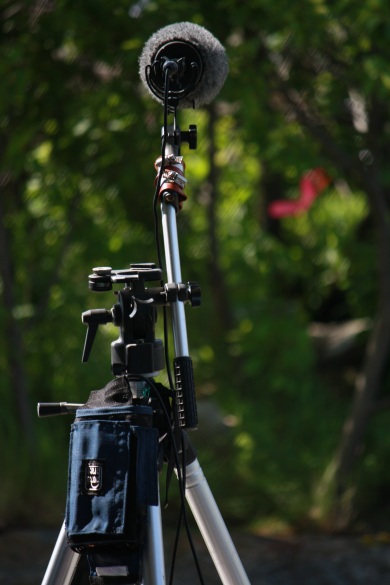
Microphone on a tripod
My goal was to record the vocal response of a gull sitting on its nest as I walked up to it, creating a graded increase in threat-level. The last time I tried, sans tripod, the gulls were having none of it. They would fly away and refuse to return to the nest, however well I might be concealed in the shrubbery. With the tripod, however, it worked like magic.
I put the tripod down, angled the microphone, turned on the recorder and walked away, giving the bird some space and time to get used to the big slivery contraption. When I returned ten minutes later, the gull was calmly incubating its eggs with nary a care in the world. And then, of course, it started alarm calling at my approach, but that was all part of the plan.
It was a glorious morning. The sun was out, the sea was a calm, blue sheath, Yellow Warblers were singing their little hearts out in all directions, and I was gathering good data. What more can one ask for?
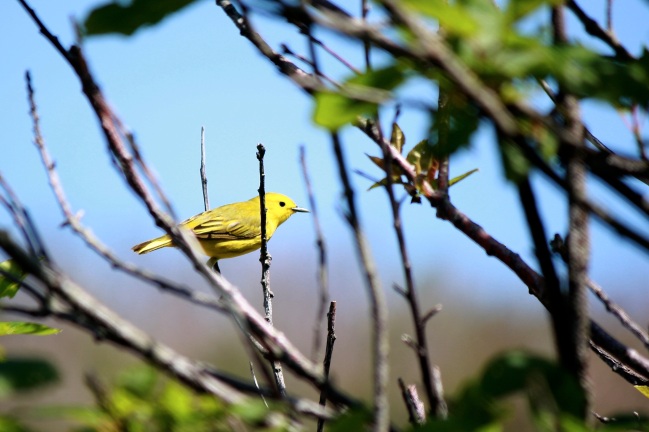
Yellow Warbler
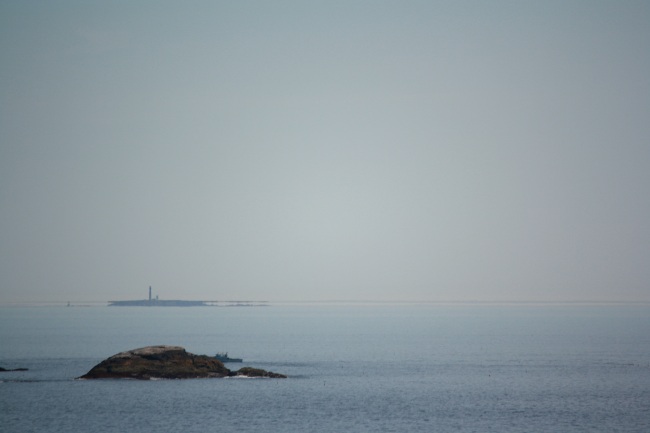
It was such a clear day that Boon Island looked like a submarine on the horizon
Unfortunately, after lunch someone decided to mow the grass, the noise bringing my recording spree to a grinding halt. The class was still away, and I was “fired” anyway, so I found myself with this extraordinary thing called free time on my hands and had no idea what to do with it. I managed to whittle it away by taking a shower, making a couple of phone calls and sketching some birds, but couldn’t shake away the anxious feeling of having forgotten to do something very important. It was my first bit of free time since school started in January!
Tuesday was also the day the first Herring Gull chick of the season hatched at one of Taylor’s nests. Dave, Sarah, and I accompanied her to the nest where Dave showed her how to take a blood sample while Sarah and I lent moral support (i.e. took pictures).
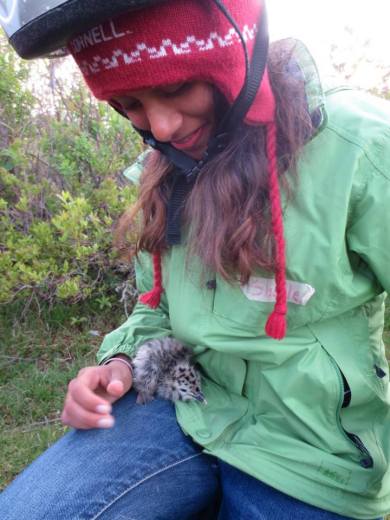
Me and the first Herring Gull chick of the year!
Wednesday threw a bit of a damper on things. Quite literally. My alarm went off at 5 30 and both Sarah and I reached over to part the curtains at the same time, revealing a monochromatic grey sky and a steady patter of raindrops.
“No!” I cried. “I can’t record in the rain! Ugh.”
“Well,” said Sarah. “I can still take GPS points…”
She climbed out of bed while I rolled over and slept in till breakfast.
After breakfast and Sarah’s raptor lecture, the two of us set out to check Great Black-backed Gull nests. It had stopped raining and there was barely any wind. The smell of freshly-fallen rain masked out the guano stink and I was happy to be out and about for I was afraid the inability to record in the rain would confine me to the indoors all day.
That, however, remained the only highlight of the day. I spent the rest of it on a couch in Laighton (the library), sipping tea and sketching, only taking a break to go listen to Sarah talk about her time working with eiders in Alaska last summer.
Oh and we watched Water for Elephants after dinner.
As if to make up for all the crummy weather, Thursday dawned bright and sunny and warm. 15 degrees Celsius. Not a cloud in the sky. I could almost feel the skin on the back of my neck turn darker as the day progressed.
Field Ornithology was off-island again – this time at White and Seavey islands to pay a visit to the Tern restoration project – and so was Evolution, the other on-going class, which meant prime recording time for me. Not that I have anything against students but the less people on the island, the less people accidentally walking by and alarming the gulls while I am recording.
I decided to target the gulls nesting close to buildings where it is usually difficult to record due to constant human activity. And as the sun climbed higher in the sky, the shaded porches became heavenly refuges where I could hide from the gulls as well as the heat.
I soon fell into a rhythm. Set up tripod near nest, retreat to shade, note down time and nest number, read a few pages of The Wind Masters while waiting for gull to calm down and get used to tripod, put on helmet and slowly walk toward gull while inwardly willing it to stay on the nest and alarm call instead of chickening out and flying away.
To the surprise of my pessimist self, most of them did, and I got over fifteen usable recordings. It may not sound like much but it’s definitely a notch up from the lousy five recordings I got last season.
That, coupled with some cool photo/video-ops such as a Great Black-backed Gull depredating a Herring Gull nest and some very co-operative Tree Swallows, plus stories of Gyrfalcons and goshawks courtesy of the book I was reading, let to a very happy and satisfied me at the end of the day.
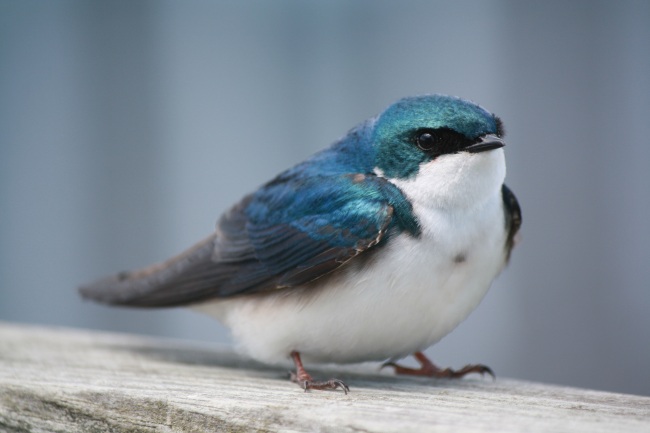
Tree Swallow on the deck of Kiggins
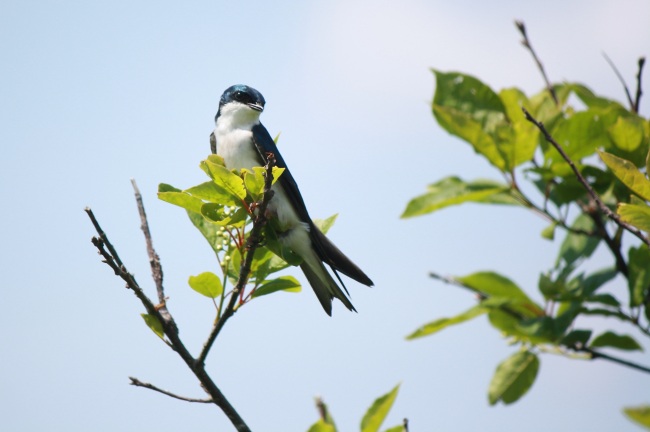
Tree Swallow outside Dorm 1
The class had spent the afternoon working on their independent projects and banding birds with Sarah and Dave, and it was nice to convene at the Sunset Pavilion after dinner and swap stories.
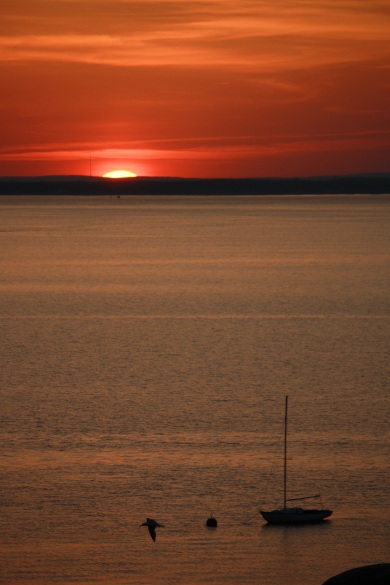
Sunset
I had one to tell myself –
It had just so happened that Kayla had spotted an awesome bird while working in the intertidal on the southern side of the island. She had snapped a photo and shown it to Sarah before lunch. After lunch, Sarah got up, put on her hat and said, “I’m going to go find the bird Kayla told me about.”
“Wait, what bird?” I asked.
“Oh, Kayla saw an [bird name] at the Half-tide Ledges this morning! Do you want to come look for it with me?”
“Of course I do! I have never seen one before!”
We grabbed our hats, binoculars and a couple of Snickers (as dessert after lunch) and hurried off down Crystal Lake trail. When we got to the Ledges, however, the tide was up and there was very little intertidal left exposed. Gulls and eiders populated what remained. We didn’t see our bird anywhere on Appledore and started scanning Smuttynose for any sign of a long red bill and a dark head.
Just as we were about to give up and head back so as not to miss Michelle’s talk about her research, we heard a couple of sweet, fluting notes and looked up to see two large shorebirds with long bills, dark heads and white wing patches flying away from Smuttynose. They banked right and disappeared behind the rocky coastline instead of landing on Appledore, but the fleeting glimpse and ethereal flight calls were enough to make me excited about having seen my first American Oystercatchers.
One Comment Add yours